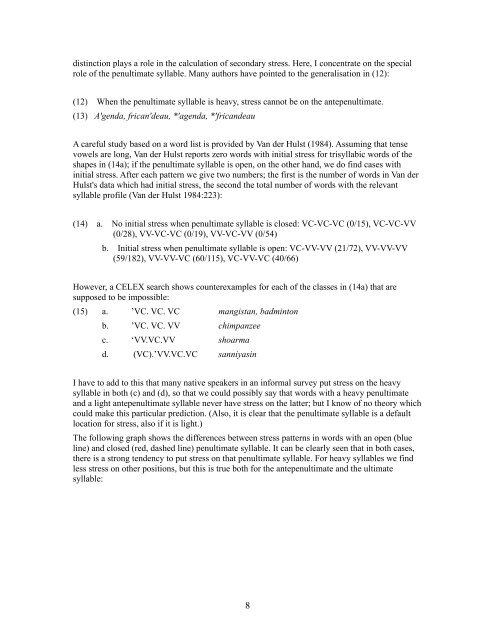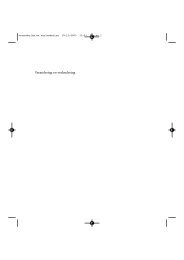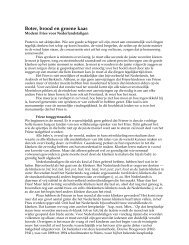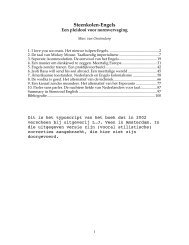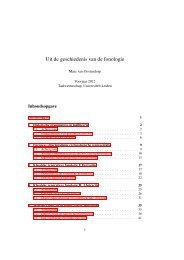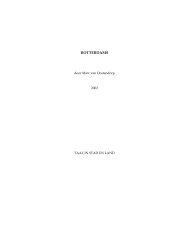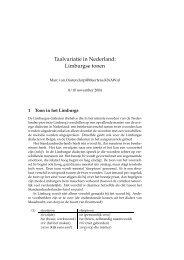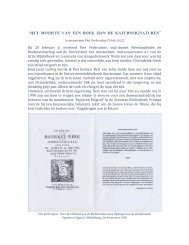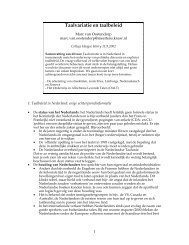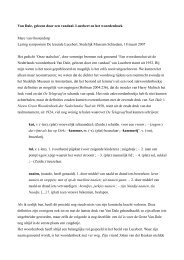Quantity and the three-syllable window in Dutch word stress 0 ...
Quantity and the three-syllable window in Dutch word stress 0 ...
Quantity and the three-syllable window in Dutch word stress 0 ...
Create successful ePaper yourself
Turn your PDF publications into a flip-book with our unique Google optimized e-Paper software.
dist<strong>in</strong>ction plays a role <strong>in</strong> <strong>the</strong> calculation of secondary <strong>stress</strong>. Here, I concentrate on <strong>the</strong> special<br />
role of <strong>the</strong> penultimate <strong>syllable</strong>. Many authors have po<strong>in</strong>ted to <strong>the</strong> generalisation <strong>in</strong> (12):<br />
(12) When <strong>the</strong> penultimate <strong>syllable</strong> is heavy, <strong>stress</strong> cannot be on <strong>the</strong> antepenultimate.<br />
(13) A'genda, frican'deau, *'agenda, *'fric<strong>and</strong>eau<br />
A careful study based on a <strong>word</strong> list is provided by Van der Hulst (1984). Assum<strong>in</strong>g that tense<br />
vowels are long, Van der Hulst reports zero <strong>word</strong>s with <strong>in</strong>itial <strong>stress</strong> for trisyllabic <strong>word</strong>s of <strong>the</strong><br />
shapes <strong>in</strong> (14a); if <strong>the</strong> penultimate <strong>syllable</strong> is open, on <strong>the</strong> o<strong>the</strong>r h<strong>and</strong>, we do f<strong>in</strong>d cases with<br />
<strong>in</strong>itial <strong>stress</strong>. After each pattern we give two numbers; <strong>the</strong> first is <strong>the</strong> number of <strong>word</strong>s <strong>in</strong> Van der<br />
Hulst's data which had <strong>in</strong>itial <strong>stress</strong>, <strong>the</strong> second <strong>the</strong> total number of <strong>word</strong>s with <strong>the</strong> relevant<br />
<strong>syllable</strong> profile (Van der Hulst 1984:223):<br />
(14) a. No <strong>in</strong>itial <strong>stress</strong> when penultimate <strong>syllable</strong> is closed: VC-VC-VC (0/15), VC-VC-VV<br />
(0/28), VV-VC-VC (0/19), VV-VC-VV (0/54)<br />
b. Initial <strong>stress</strong> when penultimate <strong>syllable</strong> is open: VC-VV-VV (21/72), VV-VV-VV<br />
(59/182), VV-VV-VC (60/115), VC-VV-VC (40/66)<br />
However, a CELEX search shows counterexamples for each of <strong>the</strong> classes <strong>in</strong> (14a) that are<br />
supposed to be impossible:<br />
(15) a. ’VC. VC. VC mangistan, badm<strong>in</strong>ton<br />
b. ’VC. VC. VV chimpanzee<br />
c. ‘VV.VC.VV shoarma<br />
d. (VC).’VV.VC.VC sanniyas<strong>in</strong><br />
I have to add to this that many native speakers <strong>in</strong> an <strong>in</strong>formal survey put <strong>stress</strong> on <strong>the</strong> heavy<br />
<strong>syllable</strong> <strong>in</strong> both (c) <strong>and</strong> (d), so that we could possibly say that <strong>word</strong>s with a heavy penultimate<br />
<strong>and</strong> a light antepenultimate <strong>syllable</strong> never have <strong>stress</strong> on <strong>the</strong> latter; but I know of no <strong>the</strong>ory which<br />
could make this particular prediction. (Also, it is clear that <strong>the</strong> penultimate <strong>syllable</strong> is a default<br />
location for <strong>stress</strong>, also if it is light.)<br />
The follow<strong>in</strong>g graph shows <strong>the</strong> differences between <strong>stress</strong> patterns <strong>in</strong> <strong>word</strong>s with an open (blue<br />
l<strong>in</strong>e) <strong>and</strong> closed (red, dashed l<strong>in</strong>e) penultimate <strong>syllable</strong>. It can be clearly seen that <strong>in</strong> both cases,<br />
<strong>the</strong>re is a strong tendency to put <strong>stress</strong> on that penultimate <strong>syllable</strong>. For heavy <strong>syllable</strong>s we f<strong>in</strong>d<br />
less <strong>stress</strong> on o<strong>the</strong>r positions, but this is true both for <strong>the</strong> antepenultimate <strong>and</strong> <strong>the</strong> ultimate<br />
<strong>syllable</strong>:<br />
8


